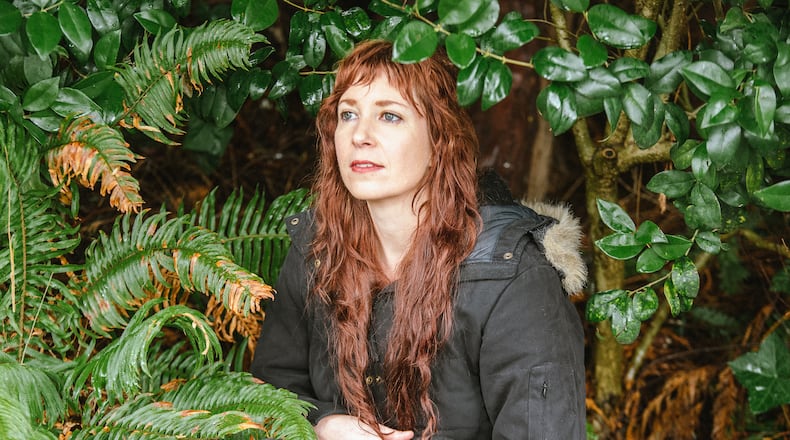Duke University professor Mesha Maren’s third novel “Shae” is an aching Appalachian coming-of-age story about a relationship between two teenagers who navigate a raw and courageous journey through the crossroads of identity and addiction. As much an homage to her home state of West Virginia as a nod to those who have struggled to survive small-town limitations, Maren delivers a profoundly intimate study on alienation and how the catastrophic impact of pain and dependency ripples through communities.
Shae Phillips is a 16-year-old student who is mesmerized the first time she sees Cameron “Cam” Burns on the school bus. New in town, Cam is a year older and “so shiny,” with glistening blonde hair, a pierced nose and ears, and a feminine quality that captivates Shae’s attention. Cam’s long hair and baggy clothes stand out from the other Greenbriar County high school kids — resulting in being bullied, kicked off the bus and forced to walk home.
As a person who feels invisible, Shae is strangely envious of the negative attention Cam receives. She’s drawn in by the alluring combination of Cam’s self-confidence and individuality and goes out of her way to ensure their paths intersect. Cam is an aspiring singer and they eventually bond over heavy metal music and agonizingly slow dial-up internet.
Maren immerses her story in Shae’s point of view and doesn’t deviate, cutting to the root of isolation by shaping the tone of her book around a character who radiates melancholy and confusion. Describing her loneliness as “wild and huge,” Shae “wanted so badly to avoid the things (she) didn’t understand, to rush right over any discussion.” This includes Cam’s gender.
Shae perceives Cam as a girl, while others see Cam as male. Without revealing Cam’s intentions, Maren demonstrates how the character’s identity gradually evolves — along with other people’s reaction.
Shae’s mom Donna works at the school and is excited her daughter has made a friend, regardless of gender. Instead, she focuses on Cam’s well-being. Recently orphaned by a drug-addict mother, Cam now lives with a grandfather who doesn’t spend much time at home. Before long, Cam is a frequent presence at the Philips home, driving Donna’s car, sharing in their family cellphone plan and staying overnight.
It soon becomes obvious that Cam is a ray of sunshine in the Philips family’s quiet lives. Shae notes that the sound of Donna’s laughter was foreign to her ears until Cam arrives, and she observes an increase in her own happiness. Everyday tasks like helping her mom in the school cafeteria, become enjoyable now that Cam is there to turn their chores into a dance party.
Shae’s dad Rodney, a big-rig trucker who comes home every few weeks, is also accepting of Cam and doesn’t mind Cam hanging out “with his daughter all the time the same way he would’ve with other guys.” Rodney is far from pleased, however, when Shae becomes pregnant.
Morning sickness and the reality of teenage motherhood hit Shae hard. She struggles to adapt to home schooling and what it will take to care for a child. Shae acknowledges how much Donna does for her and recognizes, especially compared to Cam, that “my whole life had been one big soft bed.”
Credit: Handout
Credit: Handout
Meanwhile, Cam begins to blossom, trying on clothes Shae’s pregnant figure can no longer wear, cultivating outside friendships and joining a heavy metal band.
Shae is entranced by Cam’s transformation but too self-conscious to address her feelings. Unable to articulate the storm brewing inside, she grows fearful Cam will soon realize Shae isn’t worth her time.
In a transcendent moment, Cam appears on stage at a band concert wearing a miniskirt and midriff top, legs shaved, “eyes ringed” and “lips rouged,” and announces her pronouns are she and her. Shae feels simultaneously in awe and left behind.
Her alienation increases after her daughter Eva is born via a botched caesarean section that leaves Shae with an untreated infection and agonizing pain. The first oxycodone she takes in the hospital makes the world feel “tender, cupped around me like hands around a tiny flame” and allows her to escape both her physical and mental anguish. That is the sensation she spends the rest of the novel desperate to duplicate as her addiction becomes the narrative focus.
Still attached to a catheter, Shae spends Eva’s early days flowing in and out of an oxy daze. Donna and Cam care for the baby, ensuring that mother and child are never left unattended. By the time Shae heals from a second surgery, she’s addicted to opioids and her doctor has cut off her prescription. Life becomes complicated for everyone as she struggles to maintain the funds and relationships required to feed her dependency.
As Shae devolves into addiction, Cam continues to transition with hormone therapy and decides to go to college. Their coming-of-age journeys take drastically different routes. One is a successful exploration of identity, the other a heartbreaking portrait of pain.
Despite the harsh realities depicted in “Shae,” Mesha Maren portrays the struggles of her fellow West Virginians with a tenderness that speaks of her deep compassion — for folks seeking to define their own identities as well as those searching for a place to belong.
FICTION
“Shae”
by Mesha Maren
Algonquin Books
224 pages, $28
About the Author
Keep Reading
The Latest
Featured



